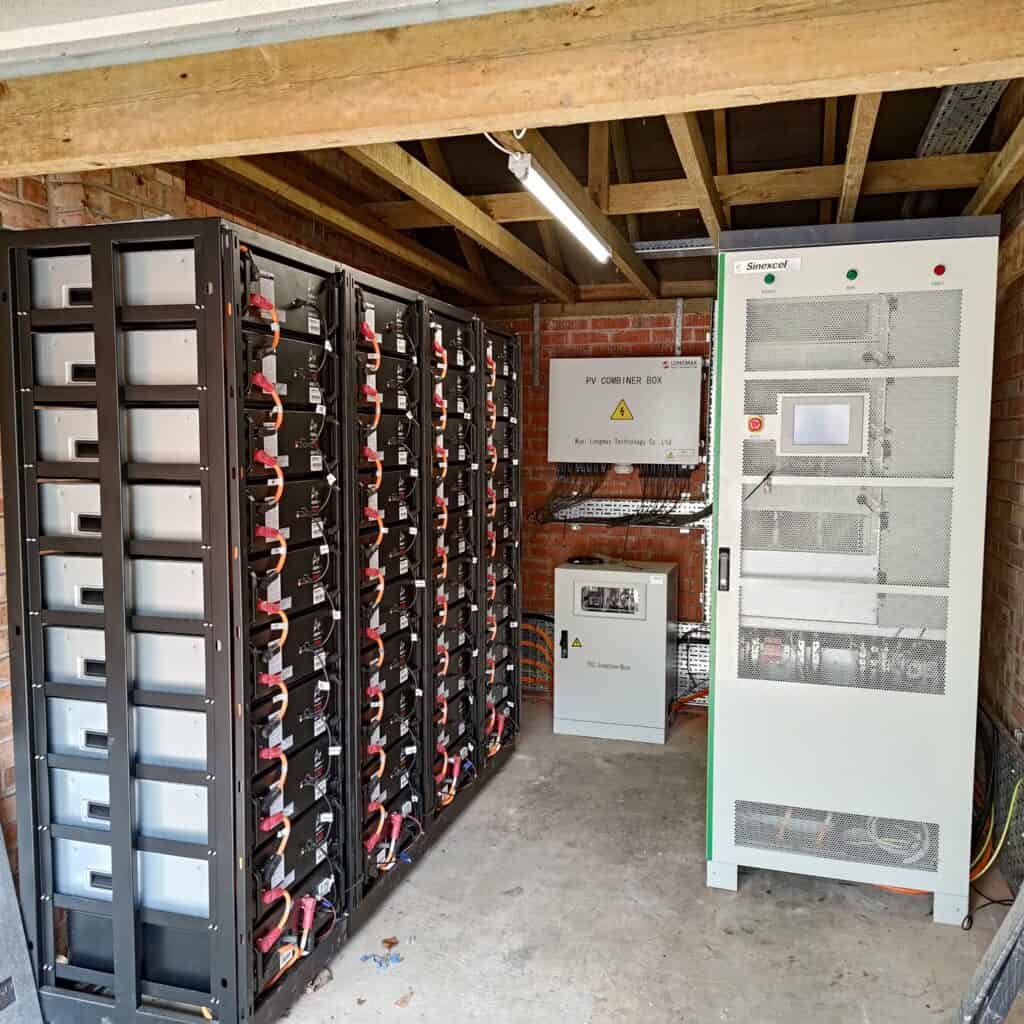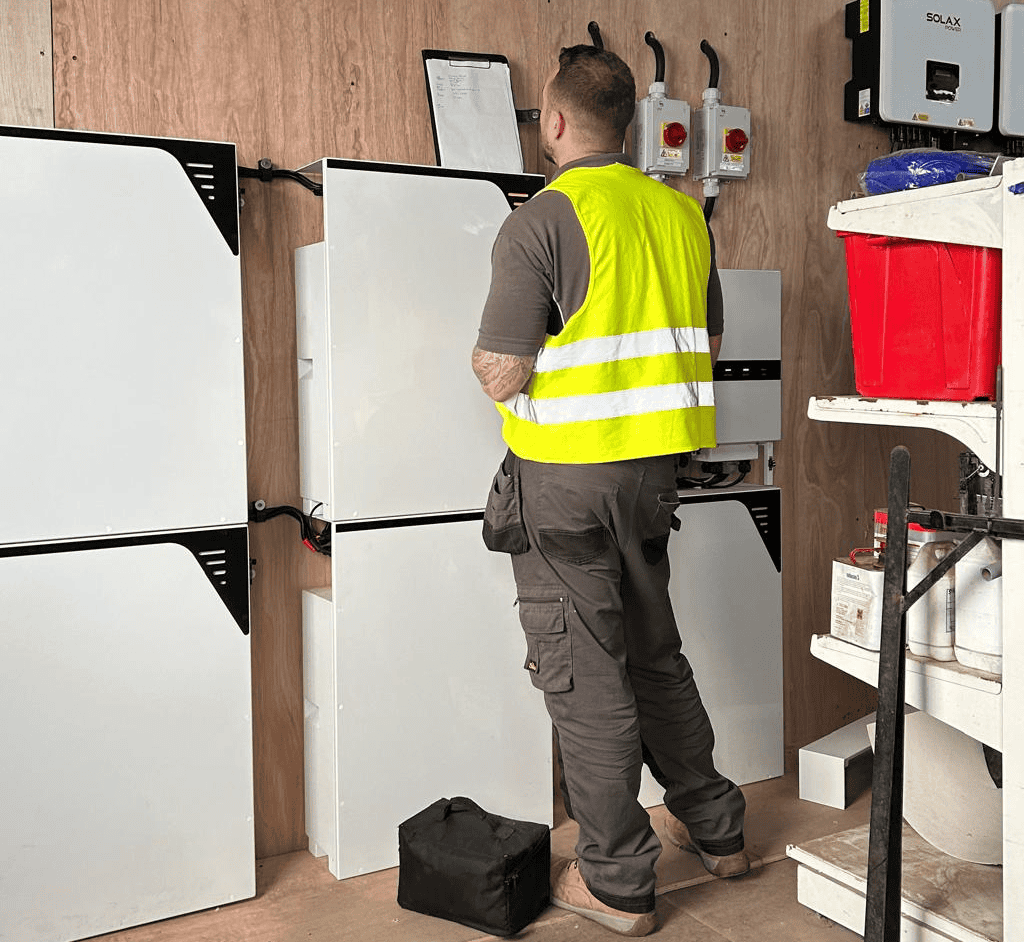Adding Battery Storage to an Existing Solar Array: A Guide

Many Businesses have already taken the leap into solar energy and have experienced very positive results. You may now be hearing about the benefits of adding battery storage to the solar and wondering how it all works. Battery storage, or BESS (Battery Energy Storage Systems) can easily improve your business performance, both financially and environmentally. This article delves into how it all works, what’s involved, and some of the finer details to consider.
Understanding the Basics
To put it simply, a commercial battery setup will allow you to store excess energy generated from your solar panels. Instead of selling the excess back to the grid at a low price, you can save it for future use. This can be very effective during peak energy demand times when costs are higher, or when the solar panels are not producing enough power. Using storage this way, businesses can significantly reduce their reliance on the grid, decreasing their energy costs even further. Another use for BESS is to charge the batteries with cheaper, off-peak power, ie during the night. This electricity can then be used during peak times when the cost is higher. A third benefit is keeping a reserve charge to ensure uptime during an emergency or power cut.
The Benefits of Adding Battery Storage
1. Energy Cost Savings
The biggest benefit of adding BESS to your solar panels will probably be the potential for significant cost savings. By maximising the yield from your solar array and strategic charging/discharging, you can decrease the average unit cost of your electricity. This should lead to substantial savings over time, especially for those businesses with particularly high electricity usage.
2. Increased Energy Independence
Downtime can be costly and can even damage sensitive equipment. Adding a BESS to your system provides a robust backup power supply. This is most important in case of power cuts. This ensures a smooth business continuity and removes the risk of any grid volatility. If your business relies on being able to constantly operate smoothly, then this should be quite a big consideration.
3. Enhanced Sustainability
Using stored solar energy reduces your dependence on fossil fuels, which are often used to generate electricity for the grid. This not only lowers your carbon footprint but also supports broader sustainability goals. It’s a win-win for both your business and the environment. As time goes by, factors like these are also becoming more and more important to prospective clients and customers.
Some examples
Let’s look at a couple of real-world examples to see how integrating battery storage with existing solar arrays has already benefited UK businesses.
1: The University of Sheffield
The University of Sheffield has been a pioneer in adopting renewable energy solutions. With its commitment to sustainability, the university installed a substantial solar array on its rooftops. To further enhance energy efficiency, the university then integrated a large-scale battery storage system. This system allows the university to store excess solar energy generated during the day and use it during peak demand periods and at night. As a result, the university has significantly reduced its energy costs and improved its energy independence. Moreover, this integration has contributed to the university’s goal of reducing its carbon emissions and promoting the environment on campus.
2: Sainsbury’s Supermarkets
Sainsbury’s, one of the UK’s leading supermarket chains, has also embraced the integration of battery storage with solar arrays. Many Sainsbury’s stores are equipped with rooftop solar panels that generate a substantial amount of electricity. By adding battery storage, these stores can store excess solar energy and use it during peak hours when electricity costs are highest. This strategy has led to considerable cost savings across the chain, making it more competitive and environmentally friendly. Furthermore, the use of battery storage ensures that Sainsbury’s stores have a reliable power supply, even during grid outages, enhancing the shopping experience for customers.
Key Considerations for adding BESS to your solar array
Adding battery storage to your existing solar array involves several important considerations. Here’s what you need to know to ensure a successful integration.
1. Assessing Your Energy Needs
Before we start, the first thing to do is assess your current and future energy needs. This involves analysing your energy consumption patterns, identifying periods of peak demand, and understanding how much excess energy your solar array produces. Immersa use complex modelling software to do this for your business. We look at not just your current, but your predicted future use as well. This assessment will help determine the size and type of battery storage system that’s best suited for your business.
2. Choosing the Right Battery Technology
There are several types of battery technologies available, each with its advantages and disadvantages. When deciding on which manufacturer to choose, it is important to understand the difference. LiFePO4 batteries, such as those used in our Alpha ESS systems are chosen for several reasons. We acknowledge them as being the best choice for lifespan, safety and the environment. Read more about them here.
3. Evaluating Costs, Incentives and ROI
While the initial cost of BESS can be high, it’s important to consider the long-term savings and potential incentives available. Many governments offer financial incentives, tax credits, and rebates for businesses that invest in renewable energy solutions. These incentives can significantly offset the initial costs and improve the return on investment.

4. Ensuring Compatibility
When integrating battery storage with your existing solar array, compatibility is key. Not all battery systems are compatible with all types of solar inverters and panels. Working with an experienced provider like Immersa can ensure that your battery storage system is fully compatible with your existing setup and optimized for maximum efficiency.
Steps to Successful Integration:
Here are the key steps to expect when going through the process of adding BESS to your solar setup:
1. Consultation and Assessment
First, you’ll need to start with a thorough consultation and energy assessment with a trusted provider. This will involve analysing your energy needs, evaluating your current solar setup, and determining the most suitable battery storage solution.
2. System Design and Planning
Once the assessment is complete, the next step is designing and planning the integration. This includes selecting the right battery technology, ensuring compatibility with your solar array, and planning the installation process. Detailed planning is essential to minimize disruptions to your operations during installation.
3. Installation and Commissioning
The installation process involves setting up the battery storage system and integrating it with your solar array. This should be carried out by experienced technicians to ensure safety and efficiency. Once installed, the system will be tested and commissioned to verify its performance and ensure it meets your energy needs.
4. Monitoring and Maintenance
After the system is up and running, ongoing monitoring and maintenance are crucial to ensure optimal performance. Modern battery storage systems often come with monitoring software that provides real-time data on energy production, storage, and consumption. Regular maintenance checks will help identify and address any issues promptly. Your supplier may be able to offer you an ongoing Operation and Maintenance contract. It is very much worth considering this option, both for your peace of mind and to ensure the system runs at maximum efficiency year after year.
Conclusion
Integrating battery storage with your existing solar array is a smart move for any business looking to maximize energy efficiency, reduce costs, and enhance sustainability. By understanding the benefits, key considerations, and steps involved, you can ensure a successful integration that meets your business’s unique needs.
At Immersa, we specialize in providing comprehensive energy solutions tailored to your business. If you’re considering adding battery storage to your solar array, our team of experts is here to guide you through the process and help you achieve the best possible results. We have been through this process many times and are ready to help when you are ready to take the next step.
By embracing the powerful combination of solar and battery storage, your business can enjoy greater energy independence, significant cost savings, and a more sustainable future. Let’s work together to power your business with clean, reliable energy!
Visit our Commercial Battery Storage and Commercial Renewable Energy pages for more information. Fill out our enquiry form to get personalised advice and solutions tailored to your specific needs.
CONTACT
Terms and Conditions | Cookie Policy | Privacy Policy
© Immersa. All Rights Reserved.
